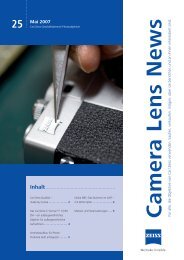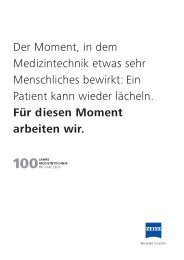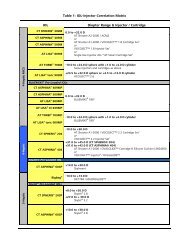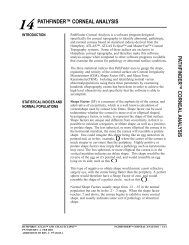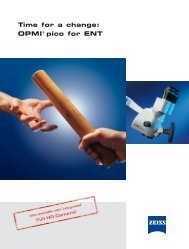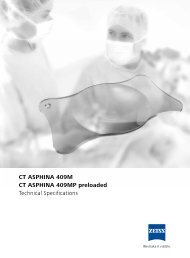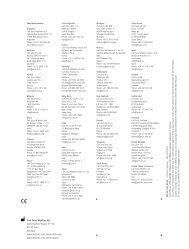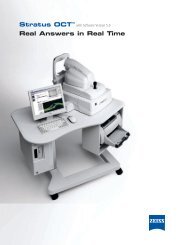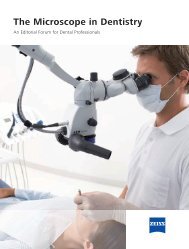Cirrus™ HD-OCT: How to read the printouts - Carl Zeiss Meditec AG
Cirrus™ HD-OCT: How to read the printouts - Carl Zeiss Meditec AG
Cirrus™ HD-OCT: How to read the printouts - Carl Zeiss Meditec AG
You also want an ePaper? Increase the reach of your titles
YUMPU automatically turns print PDFs into web optimized ePapers that Google loves.
Cirrus <strong>HD</strong>-<strong>OCT</strong>:<br />
<strong>How</strong> <strong>to</strong> <strong>read</strong> <strong>the</strong> prin<strong>to</strong>uts
Cirrus <strong>HD</strong>-<strong>OCT</strong> analysis prin<strong>to</strong>uts offer clinically relevant qualitative and<br />
quantitative information in an easy-<strong>to</strong>-<strong>read</strong> format. Analysis results can be<br />
printed, viewed via review software, or integrated with o<strong>the</strong>r instrument<br />
data through <strong>the</strong> FORUM ® Eye Care data management system. This guide<br />
explains <strong>the</strong> various areas of each prin<strong>to</strong>ut and <strong>the</strong> valuable information it<br />
provides for your clinical assessment.<br />
Learn more about Cirrus, log on <strong>to</strong> www.meditec.zeiss.com/cirrrus
Cirrus <strong>HD</strong>-<strong>OCT</strong> RNFL and<br />
ONH Analysis Report<br />
Based on <strong>the</strong> 6 mm x 6 mm data cube captured by <strong>the</strong> Optic Disc Cube 200x200 scan, this report shows assessment of RNFL and ONH<br />
for both eyes.<br />
1<br />
2<br />
3<br />
4<br />
5<br />
6<br />
7<br />
8<br />
Key parameters, compared <strong>to</strong><br />
normative data, are displayed in<br />
table format.<br />
Nerve Fiber Layer (RNFL)<br />
thickness map is a <strong>to</strong>pographical<br />
display of RNFL. An hourglass<br />
shape of yellow and red colors is<br />
typical of normal eyes.<br />
The RNFL Deviation Map<br />
shows deviation from normal.<br />
<strong>OCT</strong> en face fundus image shows<br />
boundaries of <strong>the</strong> cup and disc<br />
and <strong>the</strong> RNFL calculation circle.<br />
Neuro-retinal Rim Thickness<br />
profile is matched <strong>to</strong> normative<br />
data.<br />
RNFL TSNIT graph displays<br />
patient’s RNFL measurement<br />
along <strong>the</strong> calculation circle,<br />
compared <strong>to</strong> normative data.<br />
RNFL Quadrant and Clock<br />
Hour average thickness is<br />
matched <strong>to</strong> normative data.<br />
Horizontal and vertical<br />
B-scans are extracted from <strong>the</strong><br />
data cube through <strong>the</strong> center<br />
of <strong>the</strong> disc. RPE layer and disc<br />
boundaries are shown in black.<br />
ILM and cup boundaries are<br />
shown in red.<br />
RNFL calculation circle is<br />
extracted from <strong>the</strong> data cube,<br />
and au<strong>to</strong>matically centered on<br />
<strong>the</strong> optic disc. Boundaries of<br />
<strong>the</strong> RNFL layer segmentation<br />
are illustrated.<br />
7<br />
3<br />
8<br />
2<br />
1<br />
6<br />
6<br />
4<br />
5<br />
1
2<br />
RNFL and ONH Analysis Report<br />
Optional Patient Education Page<br />
1<br />
2<br />
<strong>OCT</strong> fundus image with<br />
deviation map facilitates<br />
discussion with patient.<br />
RNFL peripapillary thickness<br />
profile is shown for each eye,<br />
providing easier visualization and<br />
comprehension.<br />
Distribution of Normals<br />
Color coded indication of normative data comparison for RNFL and ONH.<br />
2<br />
1<br />
Distribution of Normals:<br />
The thickest 5% of measurements fall in <strong>the</strong> white area.<br />
90% of measurements fall in <strong>the</strong> green area.<br />
The thinnest 5% of measurements fall in <strong>the</strong> yellow area or below.<br />
The thinnest 1% of measurements fall in <strong>the</strong> red area. Measurements in red are considered outside normal limits.<br />
ONH values will be shown in gray when <strong>the</strong> disc area does not match with normative data.
Cirrus <strong>HD</strong>-<strong>OCT</strong> GPA Report<br />
With Guided Progression Analysis (GPA ), Cirrus <strong>HD</strong>-<strong>OCT</strong> can aid in <strong>the</strong> identification of glaucoma progression through event analysis and<br />
trend analysis. Event analysis assesses changes that are beyond an expected variability at certain points compared <strong>to</strong> normative data. If a<br />
patient falls outside this range, it is identified as progression. Trend analysis looks at <strong>the</strong> rate of change over time, using linear regression<br />
<strong>to</strong> determine whe<strong>the</strong>r or not <strong>the</strong> trend is outside <strong>the</strong> expected rate of RNFL loss.<br />
1<br />
2<br />
3<br />
4<br />
5<br />
RNFL Thickness Maps provide<br />
a <strong>to</strong>pographical display of RNFL<br />
for each exam.<br />
RNFL Thickness Change<br />
Maps demonstrate change in<br />
RNFL between exams. Up <strong>to</strong> 6<br />
progression maps are compared<br />
<strong>to</strong> baseline. Areas of statistically<br />
significant change are colorcoded<br />
yellow when first noted<br />
and <strong>the</strong>n red when <strong>the</strong> change<br />
is sustained over consecutive<br />
visits.<br />
Average RNFL Thickness<br />
values are plotted for each<br />
exam. Yellow marker denotes<br />
change from both baseline<br />
exams. Red marker denotes<br />
change sustained over<br />
consecutive visits. Rate and<br />
significance of change is<br />
shown in text.<br />
RNFL Thickness Profiles.<br />
TSNIT values from exams are<br />
plotted. Areas of statistically<br />
significant change are colorcoded<br />
yellow when first noted<br />
and red when <strong>the</strong> change is<br />
sustained over consecutive visits.<br />
RNFL Summary summarizes<br />
Guided Progression Analysis (GPA ) analyses and indicates<br />
with a check mark if <strong>the</strong>re is<br />
possible or likely loss of RNFL:<br />
RNFL Thickness Map Progression (best for focal change)<br />
RNFL Thickness Profiles Progression (best for broader focal change)<br />
Average RNFL Thickness Progression (best for diffuse change)<br />
3<br />
1<br />
2<br />
4<br />
5<br />
3
4<br />
Cirrus <strong>HD</strong>-<strong>OCT</strong> Anterior Segment Cube<br />
Based on <strong>the</strong> 4 mm x 4 mm data cube captured by <strong>the</strong> Anterior Segment Cube 512x128 scan, this analysis provides qualitative and<br />
quantitative evaluation of <strong>the</strong> cornea, including visualization of pathology and measurement of central corneal thickness.<br />
1<br />
2<br />
3<br />
4<br />
5<br />
Location of <strong>the</strong> scan is shown on<br />
<strong>the</strong> iris image.<br />
Slide naviga<strong>to</strong>r enables a<br />
simultaneous view of a selected<br />
point on <strong>the</strong> cornea image and<br />
<strong>OCT</strong> image displays.<br />
Central corneal thickness,<br />
in microns, is measured with<br />
calipers.<br />
Framed in blue, this image<br />
corresponds <strong>to</strong> <strong>the</strong> horizontal<br />
crosshair line of <strong>the</strong> fundus<br />
image above.<br />
Framed in pink, this image<br />
corresponds <strong>to</strong> <strong>the</strong> vertical<br />
crosshair line of <strong>the</strong> fundus<br />
image above.<br />
4<br />
5<br />
1<br />
2<br />
3
Cirrus <strong>HD</strong>-<strong>OCT</strong> Anterior Segment 5 Line Raster<br />
The Anterior Segment 5 Line Raster is used for <strong>the</strong> assessment and documentation of <strong>the</strong> cornea and irido-corneal angle.<br />
1<br />
2<br />
3<br />
4<br />
Scan angle, spacing, and length<br />
are adjustable. Parameters for<br />
<strong>the</strong> scan are indicated.<br />
Location of scan lines is shown<br />
on <strong>the</strong> iris image.<br />
The enlarged image corresponds<br />
with <strong>the</strong> location of <strong>the</strong> blue<br />
line on iris image above. The<br />
default is <strong>the</strong> center (third) scan<br />
of <strong>the</strong> five.<br />
Legend on each scan image<br />
indicates which of <strong>the</strong> 5 scan<br />
lines is displayed.<br />
1<br />
2<br />
3<br />
4<br />
5
6<br />
Cirrus <strong>HD</strong>-<strong>OCT</strong> Enhanced <strong>HD</strong> Raster Report<br />
The Enhanced <strong>HD</strong> 5 Line Raster scan pro<strong>to</strong>col collects more data per scan location than <strong>the</strong> o<strong>the</strong>r Cirrus scans, and proprietary Selective<br />
Pixel Profiling evaluates all of <strong>the</strong> pixel data <strong>to</strong> construct <strong>the</strong> best possible image.<br />
1<br />
2<br />
3<br />
4<br />
Scan angle, spacing, and length<br />
are adjustable. Parameters for<br />
<strong>the</strong> scan are indicated.<br />
Location of scan lines is shown<br />
on <strong>the</strong> LSO fundus image.<br />
Each of <strong>the</strong> 5 lines is scanned 4<br />
times and, with Selective Pixel<br />
Profiling, <strong>the</strong> optimal image is<br />
displayed. The enlarged image<br />
corresponds with <strong>the</strong> location of<br />
<strong>the</strong> blue line on fundus image<br />
above. The default is <strong>the</strong> center<br />
(third) scan of <strong>the</strong> five.<br />
Legend on each scan image<br />
indicates which of <strong>the</strong> 5 scan<br />
lines is displayed.<br />
1<br />
2<br />
3<br />
4
Cirrus <strong>HD</strong>-<strong>OCT</strong> Enhanced <strong>HD</strong> Raster 20x Report<br />
The Enhanced <strong>HD</strong> 20 Line Raster scan pro<strong>to</strong>col collects more data per scan location than <strong>the</strong> o<strong>the</strong>r Cirrus scans, and proprietary Selective<br />
Pixel Profiling evaluates all of <strong>the</strong> pixel data <strong>to</strong> construct <strong>the</strong> best possible image.<br />
1<br />
2<br />
3<br />
Scan angle, spacing, and length<br />
are adjustable. Parameters for<br />
<strong>the</strong> scan are indicated.<br />
Location of scan line is shown<br />
on <strong>the</strong> LSO fundus image.<br />
With 0 mm spacing, <strong>the</strong> 20 lines<br />
of <strong>the</strong> Enhanced <strong>HD</strong> raster are<br />
collapsed in<strong>to</strong> one line scanned<br />
20 times and with Selective<br />
Pixel Profiling, <strong>the</strong> optimal<br />
image is displayed.<br />
1<br />
2<br />
3<br />
7
8<br />
Cirrus <strong>HD</strong>-<strong>OCT</strong> Macular Cube<br />
Analysis Report<br />
Based on <strong>the</strong> 6 mm x 6 mm data cube captured by <strong>the</strong> Macular Cube 512x128 or 200x200 scan, this analysis provides qualitative and<br />
quantitative evaluation of <strong>the</strong> retina.<br />
1<br />
2<br />
3<br />
4<br />
5<br />
6<br />
7<br />
8<br />
9<br />
10<br />
LSO fundus image is shown<br />
here with a ILM-RPE retinal<br />
thickness map overlay.<br />
Slide naviga<strong>to</strong>r enables a<br />
simultaneous view of a selected<br />
point on LSO image, <strong>OCT</strong> fundus<br />
image, retinal thickness map,<br />
layer maps, and <strong>OCT</strong> image<br />
displays.<br />
ETDRS grid is au<strong>to</strong>matically<br />
centered on <strong>the</strong> fovea with<br />
Fovea Finder. Retinal thickness<br />
values, from ILM <strong>to</strong> RPE, in<br />
microns, are compared <strong>to</strong><br />
normative data.<br />
<strong>OCT</strong> fundus image is shown.<br />
Framed in blue, this image<br />
corresponds <strong>to</strong> <strong>the</strong> horizontal<br />
crosshair line of <strong>the</strong> fundus<br />
image above.<br />
Framed in pink, this image<br />
corresponds <strong>to</strong> <strong>the</strong> vertical<br />
crosshair line of <strong>the</strong> fundus<br />
image above.<br />
3D macular thickness<br />
map shows retinal thickness<br />
in a <strong>to</strong>pographical display.<br />
Segmented ILM map.<br />
Segmented RPE map.<br />
Macular parameters,<br />
compared <strong>to</strong> normative data.<br />
1<br />
5<br />
6<br />
2<br />
3 4<br />
10<br />
7<br />
8<br />
9
Cirrus <strong>HD</strong>-<strong>OCT</strong> Advanced Visualization<br />
Cus<strong>to</strong>m Report<br />
From <strong>the</strong> Macular Cube 512x128 or 200x200 scan analysis, Advanced Visualization displays cross-sections of <strong>the</strong> image cube through<br />
three dimensions. B-scans through <strong>the</strong> X and Y axis and C-scans, or C-slabs, through <strong>the</strong> Z axis reveal unique views of <strong>the</strong> retinal tissue.<br />
1<br />
2<br />
3<br />
4<br />
5<br />
The cus<strong>to</strong>m print mode generates<br />
a single or multi-page report of<br />
tagged images from any Advanced<br />
Visualization analysis screen.<br />
Each selection is displayed with a<br />
description or companion image<br />
for orientation.<br />
This LSO fundus image is seen<br />
with a ILM-RPE retinal thickness<br />
map overlay.<br />
User-defined borders of <strong>the</strong> RPE<br />
slab can be seen on horizontal<br />
and vertical B-scan images.<br />
The resulting RPE slab image<br />
represents an average signal<br />
intensity value for each A-scan<br />
location through <strong>the</strong> defined<br />
depth of <strong>the</strong> slab. This provides<br />
a C-scan image of <strong>the</strong> RPE.<br />
LSO fundus image with ILM<br />
slab overlay reveals features<br />
of epiretinal membrane.<br />
B-scan image corresponds <strong>to</strong><br />
<strong>the</strong> horizontal crosshair line on<br />
<strong>the</strong> fundus image.<br />
2 3<br />
4 5<br />
1<br />
9
Cirrus <strong>HD</strong>-<strong>OCT</strong> Macular Change<br />
Analysis Report<br />
Change analysis can be performed with Macular Cube 512x128 or 200x200 scans. Post-acquisition registration and Fovea Finder ensures<br />
<strong>the</strong> repeatability of thickness measurements, even in subjects with AMD, DME, VRI disorders. Data is displayed for prior and current scans.<br />
1<br />
2<br />
3<br />
4<br />
5<br />
6<br />
Macular thickness over <strong>the</strong><br />
6 mm x 6 mm cube of data is<br />
displayed in a <strong>to</strong>pographical<br />
map for both exams.<br />
Macular thickness values are<br />
displayed for each sec<strong>to</strong>r of <strong>the</strong><br />
ETDRS grid.<br />
Placement of <strong>the</strong> cube scan is<br />
visualized on <strong>the</strong> LSO fundus<br />
image. The Fovea Finder <br />
feature au<strong>to</strong>matically centers <strong>the</strong><br />
analysis on <strong>the</strong> fovea.<br />
<strong>OCT</strong> fundus image from<br />
follow-up exam is au<strong>to</strong>matically<br />
registered <strong>to</strong> baseline fundus<br />
image.<br />
Change analysis map shows<br />
variance from baseline, in<br />
micrometers, and represented<br />
in color.<br />
A <strong>to</strong>mogram image from <strong>the</strong><br />
baseline scan and a precisely<br />
registered image from <strong>the</strong><br />
current scan are viewed side by<br />
side. Simultaneous visualization<br />
of corresponding images from<br />
<strong>the</strong> two scans is possible on<br />
screen in a movie mode, or by<br />
moving <strong>the</strong> slide naviga<strong>to</strong>rs.<br />
<strong>Carl</strong> <strong>Zeiss</strong> <strong>Meditec</strong>, Inc. <strong>Carl</strong> <strong>Zeiss</strong> <strong>Meditec</strong> <strong>AG</strong><br />
5160 Hacienda Drive<br />
Dublin, CA 94568<br />
USA<br />
Toll free: 1 800 341 6968<br />
Phone: +1 925 557 4100<br />
Fax: +1 925 557 4101<br />
info@meditec.zeiss.com<br />
www.meditec.zeiss.com/us<br />
1 1<br />
2 2<br />
3<br />
6 6<br />
Goeschwitzer Strasse 51-52<br />
07745 Jena<br />
Germany<br />
Phone: +49 36 41 22 03 33<br />
Fax: +49 36 41 22 01 12<br />
info@meditec.zeiss.com<br />
www.meditec.zeiss.com<br />
4<br />
5<br />
CIR.3405<br />
© 2011 by <strong>Carl</strong> <strong>Zeiss</strong> <strong>Meditec</strong>, Inc. All copyrights reserved. Advanced Visualization, Cirrus, FORUM, Fovea Finder, GPA and Selective Pixel Profiling are<br />
trademarks of <strong>Carl</strong> <strong>Zeiss</strong> <strong>Meditec</strong>, Inc. in <strong>the</strong> United States and/or o<strong>the</strong>r countries. Specifications subject <strong>to</strong> change without notice. Printed in U.S.A.



